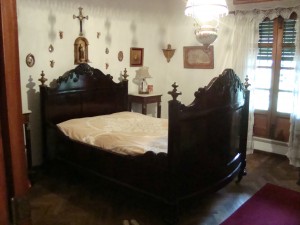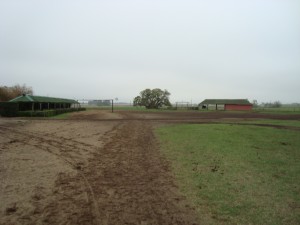Today can be summed up in two simple words: walking and learning. When the charter bus showed up and the front of the hotel this morning, we assumed we would be in for a relaxing day of sightseeing, including visits to important historical sites. However, what we did not realize exactly how much we would be walking! According to my iPhone Health App, we walked over 22,000 steps, accounting for almost 5 miles of walking (and we have not even gone to dinner yet!) But while our feet were sore by the end of the excursions, I believe there was a positive correlation between the amount of walking and the amount we learned. Today’s focus: the barrios of San Telmo and Puerto Madero.
Our first stop of the day of excursions was visiting the shops of San Telmo. We were able to see what a traditional market looks like, as well as see where the world-famous San Telmo Flea Market takes place every Sunday. Soon after, we walked to our first historical site: Zanjon de Granados and the Casa Minima. Zanjon is a museum in the heart of the neighborhood that is dedicated to showcasing the architecture of the neighborhood during the 17th-19th century. Once an semi-open home with 3 courtyards greeting guests as their entered, this site is was recently been covered to secure its reconstructed beauty. Throughout its years as a home, Zanjon served several purposes: a home for the wealthy then a safe haven for immigrants as a tenement. By examining the different bricks and water systems, archaeologists were able to identify exact purposes of each fun for the different people occupying the house. One of the biggest archaeological discoveries of this house was a tunnel system that was used for drainage. It can be determined that this was installed early when the wealth held occupancy, because it was a rare and costly amenity to have. A fun fact about the water system is that the family used turtles as cleaning tactic to eat and remove algae from their water to make it drinkable.

Underground Tunnels in Zanjon
Apart from the physical aspects of the house, due to our intelligent guide, we learned about the different ethnic influences on architecture during the 18th and 19th centuries. After the revolution, many people in Buenos Aires began to resent traditional Spanish practices. Many demonstrated this by crafting their houses to resemble other European cultures. The favorite among the wealthy was to have their houses resemble French culture. On the other hand, many not-as-affluent residencies resembled those of the Italian culture. This was because many Italians migrated to Argentina during the 18th and 19th centuries because the government hired people to market Argentina as a profitable location with a lot of land. When they immigrated, the Italians brought their traditions along with them. There was such a strong Italian influence that, at one point, their were more people who spoke Italian than those who spoke Spanish. To make sure that Spanish remained the national language, the government required students to attend an “immersion school” where they learned Spanish, the national anthem, and other traditional Argentine customs. They wanted to reduce the diversity in order to bring everyone together.

Group Picture After Visit
When we were done with the tour of Zanjon, we crossed the street and saw La Casa Minima. This was the smallest house in Buenos Aires when it was still being used as a house. While this “house” contained only a single-claustrophobic room, the house was filled with history. It was originally a part of a much larger mansion, but when slavery was abolished by the constitution in the mid-19th century, the family divided up different parts of their mansion and gave them to their former slaves so they could continue working as servants. When Yellow Fever and Cholera infected San Telmo, the wealthy inhabitants fled to the countryside, leaving their abandoned homes in the hands of their former slaves. Because the Africans stayed behind, many were killed by the disease. This is one reason why there is not a large African American presence in Argentina today.

La Casa Minima
After Zanjon and Las Casa Minima, we continued our day by walking about the neighborhood. Unfortunately, it began to rain, but that did not stop us from seeing all the Argentinian cartoons that have been made into statues and strategically placed around the neighborhood. After our walking tour of San Telmo, it was finally time for lunch! We ate at Cafe de San Juan and enjoyed a typical Italian-inspired Argentine meal.

Street Art in San Telmo
After lunch our endeavor for 10 miles of walking continues by walking the near-bye neighborhood of Puerto Madero. While Puerto Madero was one of the original 3 port locations in Buenos Aires back in the early centuries as a city, it was recently become a popular destination in BA. Today, it is the newest district and in order to live in the neighborhood, one must have an extremely well paying job or have a nice trust fund from daddy sitting in the bank. According to our guide, over 70% of the people who live in the district only live in BA for 2 months a year: it is essentially their vacation home. As we walked, be saw the skyscraper apartments, beautiful plaza, and finished off be walking through the conservatory.

OHIO at the Puerto Madero Conservatory
By the end of the day, and after all the walking, I was more than ready for a siesta!







































![IMG_1410[1]](https://u.osu.edu/argentinastudyabroadmay2015/files/2015/05/IMG_14101-1g8m2ac-300x225.jpg)
![IMG_1417[1]](https://u.osu.edu/argentinastudyabroadmay2015/files/2015/05/IMG_14171-1houyk6-300x225.jpg)
![IMG_1406[1]](https://u.osu.edu/argentinastudyabroadmay2015/files/2015/05/IMG_14061-22q610x-300x225.jpg)









 Smaller rooms for slaves with bars on the windows.
Smaller rooms for slaves with bars on the windows.

